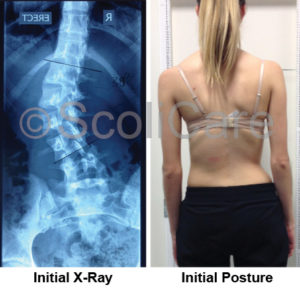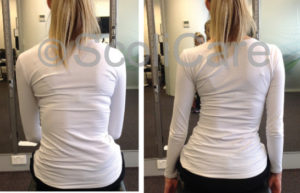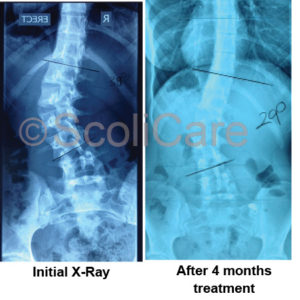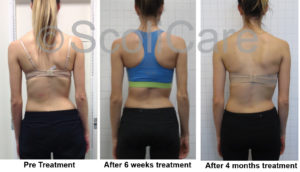Patient aged 18 with a left thoracolumbar curve measured at 39 degrees and a thoracic compensatory curve.
Background
Patient presented to the Sydney Scoliosis Clinic aged 18 at the time of initial examination. The patient had been diagnosed with scoliosis at 16 years of age, after reporting back pain and noting some postural issues (asymmetry of the waist and hips).
She was diagnosed with a left thoracolumbar curve measured at 39 degrees with a thoracic compensatory curve.
The patient had previously seen an Osteopath and Chiropractor for the pain but couldn’t seem to get relief. Her pain averaged a 6-7/10 and 9/10 at its worst. Playing sport and standing for long periods made the pain worse.
In the two years since diagnosis, the scoliosis had progressed 10 degrees. It was unlikely that the curve would progress any further with minimal growth expected due to her age.

Treatment
6 scoliosis specific rehabilitation sessions based on the SEAS approach were intitally prescribed to help stabilise the curve and decrease pain. The self-correction prescribed to the patient was specific to her scoliosis and other exercises were prescribed to increase core and lower back strength and stability.
The treatment also included the use of a scoliosis treatment aid, namely a tractioning device that the patient could use at home. She spent approximately 40mins a day at home doing the specific exercises and using the orthotic, and 1 hour a week with the Exercise Physiologist.

Results
After 4 weeks of treatment, the patient’s back pain had decreased to minimal if any, and her body had adapted to the self-correction and scoliosis orthotic allowing her to improve the range of movement of her spine.
By the 6th week, there were noticeable changes to her relaxed posture and the waist and hips were now more symmetrical. Her muscular endurance tests showed that she had improved by over 1min in both abdominals and trunk extensors over the 6 weeks. At this point the patient’s back pain averaged 0/10 most of the time and 2-3/10 occasionally when leaning over her desk studying.
The patient felt that the exercises had helped reduce the pain and her back felt a lot stronger. She also noted that lying on the orthotic helped her get relief when she was in pain.
After 4 months of treatment, an x-ray was taken and the curve had reduced from the initial 39 degrees to 29 degrees.


Conclusion
The patient now attends the clinic regularly to review exercises and assess her progress. The duration of the exercises is now approximately 10mins a day, 7 days a week to make it more manageable for the patient long-term.
Since starting the exercises program, the patient’s ability to maintain her self-correction has greatly improved and she is challenged with more advanced exercises each time she comes in for review. She is very pleased with her results, particularly the improvement in the hip asymmetry and the reduction of her pain.
NB: Results vary from case to case. Our commitment is to recommend the most appropriate treatment based on the patient’s type and severity of scoliosis.
© ScoliCare 2015